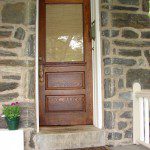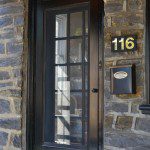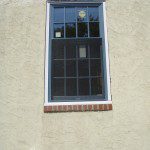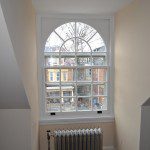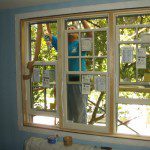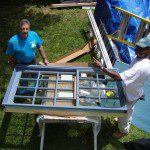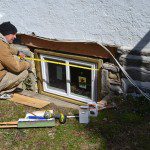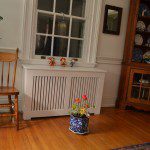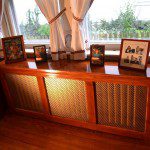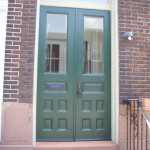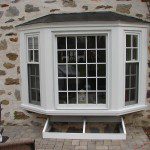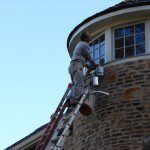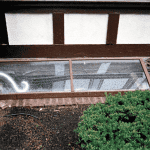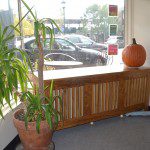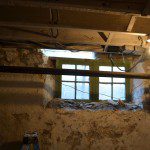Our services include restoring or replacing old windows and doors and exterior or interior storm windows. Working on many older houses we are very conscious of appearance and efficiency. It is easy for customers to forget energy efficiency is important all year.
Insulating, sealing, masonry, doors & windows all save energy and money!
“The US Department of Energy says Storm windows can reduce heat loss through the windows by 25% to 50%. Low-e storm windows save even more energy.”
Click picture and arrow on bottom for slide show.
America in 9th place for energy efficiency !
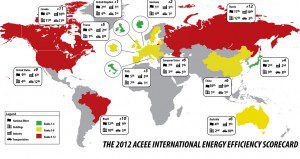
Energy Efficient Homes | National Geographic
http://greenliving.nationalgeographic.com/energy-efficient-homes/
Reducing Energy Use
http://www.epa.gov/greenhomes/ReduceEnergy.htm
Ways to Improve the Energy Efficiency of Your Home
 “Low-e”-window film can be applied to your existing windows to improve their energy efficiency.
“Low-e”-window film can be applied to your existing windows to improve their energy efficiency.While a tailored audit for your home will provide specific recommendations to improve your home, there are key areas of the home that are common trouble spots and frequently contribute to a home’s poor energy performance. These areas and the ENERGY STAR resources that can help you address these issues include:
Seal and Insulate
Your home’s envelope – the outer walls, ceilings, windows, doors and floors – may be letting too much air into or out of the home. Hidden gaps and cracks in a home can create as much airflow as an open window, and can cause your heating and cooling systems to work harder. Sealing coupled with insulating your home’s shell is often the most cost effective way to improve energy efficiency and comfort. Download the Do-it-yourself Guide to Sealing and Insulating with ENERGY STAR to better understand the importance of air sealing and insulating and key steps to sealing and insulating your home.
Windows can also account for a significant percentage of your heating bill in the winter, as cold air can infiltrate into the home through leaky windows and warm air escapes, making your heating system run more. And during the summer, your air conditioner must work harder to cool hot air from sunny windows. If you are replacing or installing windows, doors or skylights, you can reduce energy costs by installing energy-efficient windows, doors, and skylights in your home. Look for ENERGY STAR Windows, Doors, and Skylights
Heat and Cool Efficiently
 A programmable thermostat saves energy and can help make your home more comfortable.
A programmable thermostat saves energy and can help make your home more comfortable.Annual maintenance is a must for a well performing heating and cooling system. Clean your filter regularly and schedule annual maintenance by a qualified contractor. Learn how to properly install and use a programmable thermostat to save energy.
In houses with forced-air heating and cooling systems, ducts distribute conditioned air throughout the house. In a typical house, however, about 20 percent of the air that moves through the duct system is lost due to leaks and poorly sealed connections. The result is higher utility bills and difficulty keeping the house comfortable, no matter how the thermostat is set. Sealing those leaks in the ducts is a must to get better performance from your heating and cooling system. In addition, insulating ducts in unconditioned spaces that get especially hot in summer or cold in winter (such as attics, garages, or crawlspaces) can save significant energy. For more detailed information about the importance of sealing the leaks from your ducts go to http://www.energystar.gov/index.cfm?c=home_improvement.hm_improvement_ducts
If you are looking for new heating or cooling equipment, look for equipment labeled ENERGY STAR. Replacing your old heating and cooling equipment with new, energy-efficient models is a great start. But to make sure that you get the best performance, the new equipment must be properly installed. In fact, improper installation can reduce system efficiency by up to 30 percent – costing you more on your utility bills and possibly shortening the equipment’s life. For specific steps to heat and cool efficiently, follow this link to ENERGY STAR’s heat and cool efficiently page and download the Guide to Energy Efficient Heating and Cooling.
Ground Source Heat Pumps
The Earth’s heat, called geothermal energy, constantly flows outward from its core and can provide a useful supplement for heating and cooling. Unfortunately, many people think you have to live over a hotspring, a geyser or some other intense source of geothermal heat to be able to make use of this source, but this is far from the truth.
You can use geothermal energy-no matter where you live in the United States-to heat and cool your home by using a ground-source heat pump
For more information on the potential for geothermal heating/cooling in your home, go to:
http://www.energystar.gov/index.cfm?c=geo_heat.pr_geo_heat_pumps
http://apps1.eere.energy.gov/consumer/your_home/space_heating_cooling/index.cfm/mytopic=12640
Heat/Cool Portions of Your Home
Heating and cooling only those portions of your house that you use, is one way to heat and cool more efficiently. This can reduce fuel consumption, conserve energy and save you dollars while maintaining comfort. However, in using this strategy there can be potential negative side effects that must be avoided. If there are areas of your house you don’t need to use often, you can close vents and air registers to them and direct the heating or cooling to the portions of the home where you spend most of your time. Homes with central heating and cooling can benefit the most from this technique. For example, during the winter consider directing more of the heat to the family or living room if that is where you spend most of your time. If rooms are not used, you can close air registers and doors and confine heated or cooled air to the areas where you need it most. Note in winter, that the cooler parts of your home will still need to be heated to above freezing to avoid freezing pipes. Also, with some HVAC systems, especially those that are already high- performance, efficient systems, closing too many vents or registers may imbalance the entire heating and cooling system and actually make the system run less efficiently. In addition, moisture problems need to be avoided where certain rooms or areas of a house are not getting dehumidified air.
Fresh Air Cooling Strategies
Providing fresh air flow into a house is a low-cost and potentially energy-efficient way to cool a home and maintain good indoor air quality. In good weather, natural ventilation (when air moves through windows or doors) can suffice for cooling. On some days, the air temperature at night is pleasantly cool and letting this air into the house during the night can significantly cool down a house after a warm day. However, there will be times when it is too hot or humid, or pollen levels are very high, and this will not be effective — or may even be undesirable — and air conditioning may be necessary. In addition, it is important to make sure windows are closed when they need to be, such as in storms and blowing rain, and if air conditioning is finally used, that the house is closed up tightly for maximum efficiency. It makes no sense to air condition (or heat) a house with a window open! Given this, fresh air cooling takes some attention and diligence to do it right. Natural fresh air ventilation can also be supplemented by a number of low-energy mechanical ventilation devices that can help. These include:
- Ceiling fans are a useful alternative to help keep you cool while reducing or eliminating the need to use air conditioning. Typically a ceiling fan consumes much less electricity than does a central air conditioner. A ceiling fan doesn’t cool or de-humidify a room – it only cools you through a wind-chill effect against your skin. Ceiling fans are also inexpensive to purchase. Make sure, however, to turn your fan off when you leave the room. If you are not there to feel the cooling air movement on your skin, continuing to operate the fan only wastes energy.
- Window fans can also help to cool down your house in lieu of running your central air conditioning. A box fan, or other type, placed in an open window can blow cooler outside air into a room, or set in reverse, can draw cool air in through other windows and throughout the entire house. This, of course, is best done when the air outside has cooled down, such as in the evening, yet the air inside the house is still warm. Humidity conditions, pollen, dust and other factors will need to be considered when using this approach. A window fan, or portal box fan or fan on a stand can also be used in a fashion similar to a ceiling fan to blow air against your skin to create a wind chill cooling effect.
- Whole house fans help cool your home by pulling cool air through the house and exhausting warm air out of the house. Typically these are very large fans installed by professionals in the attic of a home. They are most effective when operated at night and when the outside air is cooler than inside. However, allowing them to continue to run when outdoor temperatures are hotter than indoors, defeats the purpose and will waste energy. Again, humidity conditions, pollen, dust and other factors will need to be considered when deciding to use this approach.
For more information on cooling your home through fresh air ventilation techniques, go to:
ENERGY STAR ceiling fans
Department of Energy ventilation systems Information
Look for ENERGY STAR Products
Almost half of your home’s energy use is from products you plug into the wall. You can find ENERGY STAR qualifying products for many of these products as products in over 60 different product categories now qualify for the label and offer significant savings over typically purchased products. You can start making improvements by simply purchasing energy efficient lighting and appliances labeled as ENERGY STAR. The following web pages provide additional information
 CFLs use 75 % less energy than traditional light bulbs. If every home in America replaced just one incandescent light bulb with an ENERGY STAR qualified CFL, we would save enough energy to light more than 3 million homes and prevent greenhouse gas emissions equivalent to that of 800,000 cars. Because CFLs contain trace amounts of mercury, it is important to educate yourself on proper use, recycling, and disposal of these products.
CFLs use 75 % less energy than traditional light bulbs. If every home in America replaced just one incandescent light bulb with an ENERGY STAR qualified CFL, we would save enough energy to light more than 3 million homes and prevent greenhouse gas emissions equivalent to that of 800,000 cars. Because CFLs contain trace amounts of mercury, it is important to educate yourself on proper use, recycling, and disposal of these products.ENERGY STAR lighting bulbs and fixtures – Learn about energy efficient light bulbs, fixtures (across a range of technologies), and decorative light strings (holiday lights).
ENERGY STAR Appliances – Learn about energy savings from clothes washers, dehumidifiers, dishwashers, refrigerators & freezers, room AC, and room air cleaners.
ENERGY STAR Home Electronics – Learn about energy saving battery charging systems, digital-to-analog converter boxes, cordless phones, combination units, DVD products, external power adapters, home audio, televisions, and set-top boxes.
ENERGY STAR Office Equipment – Learn about energy saving computers, copier and fax machines, digital duplicators, notebook computers/tablet PCs, mailing machines, monitors/displays, water coolers, printers, scanners, and all-in-Ones.
ENERGY STAR Water Heaters – Learn about various energy efficient water heater technologies and the ENERGY STAR specification for each water heater type.
Consider a Whole House Retrofit
Some homeowners, frustrated by high energy bills and uncomfortable homes, undertake a comprehensive solution to their energy efficiency problems. Rather than focusing on a single component, such as replacing single-paned windows, an old air conditioning system, or leaky ductwork, a qualified contractor will examine how improvements to all of these components can work together to provide greater comfort and lower utility bills. By focusing on the whole house as a system the contractor can provide the most cost-effective recommendations to improve the home. For example, a contractor may air seal and insulate a home. If this is done properly, the home will not require as large of a heating or cooling system, saving the homeowner money if replacing the system. Added benefits occur if the ducts are sealed and energy efficient windows are installed. The contractor, using special diagnostic tools, can recommend the right set of improvements to achieve the most energy savings for the least cost.
EPA, in conjunction with the Department of Energy, oversees a comprehensive retrofit program called Home Performance with ENERGY STAR. A video of Home Performance with ENERGY STAR to see what to expect from a whole house assessment may be viewed at http://www.energystar.gov/index.cfm?fuseaction=mesa.showLogin
What else can you do?
 In many parts of the country, attics get very hot in the summer and cold in the winter. Homes with HVAC systems in the attic can make their heating and cooling more efficient and effective by thoroughly sealing and insulating the HVAC ducts. In addition, insulating the underside of the roof can greatly reduce the build up of heat in the attic.
In many parts of the country, attics get very hot in the summer and cold in the winter. Homes with HVAC systems in the attic can make their heating and cooling more efficient and effective by thoroughly sealing and insulating the HVAC ducts. In addition, insulating the underside of the roof can greatly reduce the build up of heat in the attic.There are several additional ways to improve the energy efficiency of your home.
Roofing
Over 90 percent of the roofs in the United States are dark-colored. These low-reflectance surfaces reach temperatures of 150 to 190°F (66 to 88°C) during hot weather and contribute to increased cooling energy use and higher utility bills. In contrast, lighter-colored “cool roofs” with high reflectance and emissivity can stay up to 70°F (39°C) cooler than traditional materials during peak summer weather. Benefits of cool roofs include reduced building heat-gain and saving on summertime air conditioning expenditures. By minimizing energy use, cool roofs do more than save money they reduce the demand for electric power and resulting air pollution and greenhouse gas emissions. An ENERGY STAR qualified roofdecreases the amount of heat transferred into your home
Natural Lighting/Daylighting
You can increase the energy efficiency and reduce the climate impact of your home by taking advantage of the natural light windows and skylights can bring in, often referred to as “daylighting.” Daylighting is simply the use of natural sunlight to brighten up and warm a home’s interior. Today’s highly energy-efficient windows, as well as advances in lighting design, allow of windows to reduce the need for artificial lighting during daylight hours without causing heating or cooling problems. The more natural light available, the less we have to rely on energy to run light fixtures. Daylighting also helps improve your home’s aesthetic feel. Using light-colored wall paints can also help brighten up a room and reflect more daylight throughout the space.
For more information on daylighting, go to:
http://apps1.eere.energy.gov/consumer/your_home/lighting_daylighting/index.cfm/mytopic=12290
Supplemental Heating Sources
You can increase the energy efficiency and reduce the climate impact of your home by taking advantage of the natural light windows and skylights can bring in, often referred to as “daylighting.” Daylighting is simply the use of natural sunlight to brighten up and warm a home’s interior. Today’s highly energy-efficient windows, as well as advances in lighting design, allow for windows to reduce the need for artificial lighting during daylight hours without causing heating or cooling problems. The more natural light available, the less we have to rely on energy to run light fixtures. Daylighting also helps improve your home’s aesthetic feel. Using light-colored wall paints can also help brighten up a room and reflect more daylight throughout the space.
Wood Stoves
A wood stove can be a significant source of supplemental heat in your home and another way for you to save money on your energy bills. Today’s wood stove models feature improved safety, efficiency and lower emissions. If installed and operated correctly, they produce almost no smoke, minimal ash, and require less firewood than older models. They can be sized to heat a family room, a small cottage, or a full-sized home.
 Wood stoves can provide supplemental heat to a home. EPA certified wood stoves burn cleaner and more efficiently than older models.
Wood stoves can provide supplemental heat to a home. EPA certified wood stoves burn cleaner and more efficiently than older models.However, woodstoves take time and effort and a steady supply of wood for fuel. If you buy it, firewood can be expensive in some locations and a chore to store and transport into the house. Wood stored inside the house can lead to insect problems. Wood stoves need considerable attention to ignite and operate correctly and the ashes need to be carefully cleaned out periodically, which can be a messy job. If not operated correctly, wood stoves can generate smoke and other pollutants that can lead to poor indoor air quality.
If you are willing to take on these challenges, a wood stove may be a good choice for you to help reduce your traditional heating costs.
For more information to help you choose an EPA certified wood stove or fireplace insert, or another cleaner burning hearth appliance (e.g., gas or pellet stove), go to:http://www.epa.gov/burnwise/woodstoves.html
You should never smell smoke in your home when using a wood stove. Also, any smoke that escapes from your wood stove unburned is wasted fuel that will stick in your chimney as creosote or be released as air pollution. The odor of smoke in your home indicates that your wood stove is not operating efficiently or safely and may lead to indoor air quality problems.
For more information about wood burning efficiency and safety, go to:
http://www.epa.gov/woodstoves/efficiently.html
Fireplaces
Fireplaces are not very energy efficient. Although a fire in an open fireplace may provide ambience, an open fireplace typically draws more heat out of a house than it provides. To save energy, keep your fireplace damper closed unless a fire is going. Keeping the damper open is like keeping a window wide open during the winter; it allows warm air to go right up the chimney. When you use the fireplace, turn down your thermostat for the rooms warmed by the fire.
Hot Water Systems
 If you have an older water heater, and it feels warm to touch on the outside of the tank, adding a layer of insulation around the tank can help save energy.
If you have an older water heater, and it feels warm to touch on the outside of the tank, adding a layer of insulation around the tank can help save energy.Water heating is one of the largest energy expenses in your home, after space heating and cooling, which are the first and second largest expenses, respectively. You can reduce your monthly water heating bills by selecting an efficient water heater for your home or pool-such as tankless, heat pump, or solar hot water heaters-and by using some energy-efficient water heating strategies.
For more information on energy efficient hot water heaters, including how they work and whether one might be right for your home, go to:
http://www.energystar.gov/index.cfm?c=water_heat.pr_water_heaters
http://www.energystar.gov/index.cfm?fuseaction=popuptool.atHome
Water Heating Strategies
One of the easiest ways to cut your water heating bills is to insulate your older hot water heater and your hot and cold water pipes.
For more information on hot water heater and pipe insulation, go to:
http://apps1.eere.energy.gov/consumer/your_home/water_heating/index.cfm/mytopic=13070


